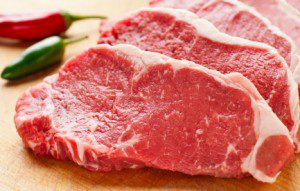
Lamb contains the highest amount of fat, and beef and kangaroo are the considered to be the most nutritious because it provides the body with many essential nutrients, but it also goes without saying that it should be trimmed of visible fat and opt to use the leaner cuts.
Debates and discussions over red meat and its effect on the body and whether it is healthy for us are endless. You can see it everywhere; it could be in the health magazine, newspaper, television or internet.
So the question is – should we eat red meat or not? Read on to find out the advantages and disadvantages of eating red meat and does it help or hinder our weight loss and healthy eating plans.
Benefits:
- It is an excellent source of iron. Iron keeps our blood healthy; it is needed for blood formation and function. Iron from red meat is easily utilized by the body; it can help prevent iron-deficiency in children and anemia in adults.
- It is an excellent source of complete proteins. It contains all the amino acids that our body needs which are needed for muscle development and repairing tissues.
- It is a good source of zinc. Zinc is an immunity booster. It is also responsible for growth and development especially among children; it helps in rapid wound healing and resistance to infection especially among the elderly.
- It is a good source of B-vitamins, including vitamin B12 which is not present in foods of plant origin. These vitamins are needed by the body to maintain healthy nerves and also for blood formation.
- It is a good source of phosphorous. The phosphorous we get from red meat is easily absorbed than what we can get from plant sources.
- It contains trace minerals potassium, magnesium and selenium; these are needed by the body to function properly.
- It taste delicious and is versatile. You can prepare it in so many ways.
- It aids in weight loss. Experts concluded that the protein in red meat makes the individual feel less hungry and could go without food for several hours, limiting their calorie intake in the process.
Health Risks:
1. For people who eat more than 2 servings of red meat per week increase their risk of getting bowel cancer.
2. Red meat contains high amounts of saturated fat and cholesterol which can cause plaque formation in the arteries that may also lead to heart disease and high blood pressure.
3. Eating too much of red meat increases risk of Arthritis. Experts believe that the collagen in red meat may trigger an immune system response which may lead to joint problems. Food additives or preservatives found in processed meats may also aggravate the disease.
4. Too much red meat in the diet may lead to a high acid environment which may also lead to a higher risk of osteoporosis.
5. A diet low in red meat decrease the risk of Alzheimer’s disease. Researchers linked this to the Mediterranean Diet wherein red meat consumption is low as compared to those in the US wherein the later has higher incidence of such condition. And also men eat more red meat than women, and that would explain why it is most common in men.
6. A study conducted by the Harvard Medical School linked eating more than 100g of red meat a day could double the risk of a woman developing breast cancer.
The bottom line is that we can include red meat as a part of a healthy diet. We don’t have to restrict ourselves to plant food. A well-balanced diet is still the key in achieving optimum health. Do not go beyond what is the recommended amount, over-doing it would definitely lead to several health concerns. Red meat do not contain any fiber at all, so it must be paired up with foods rich in fiber like leafy greens, whole grains, root vegetables, beans and legumes. Also stay away from processed meats – these include bacon, ham, luncheon meat, hotdog, sausages, and corned beef. The additives in them would increase your risk to develop certain forms of cancer.
So what is the truth about red meat? In essence, it all comes down to the type of red meat, and how you prepare and eat it.
To see our 28 Day Diet & Exercise Plan – where red meat is included in moderation, click here
